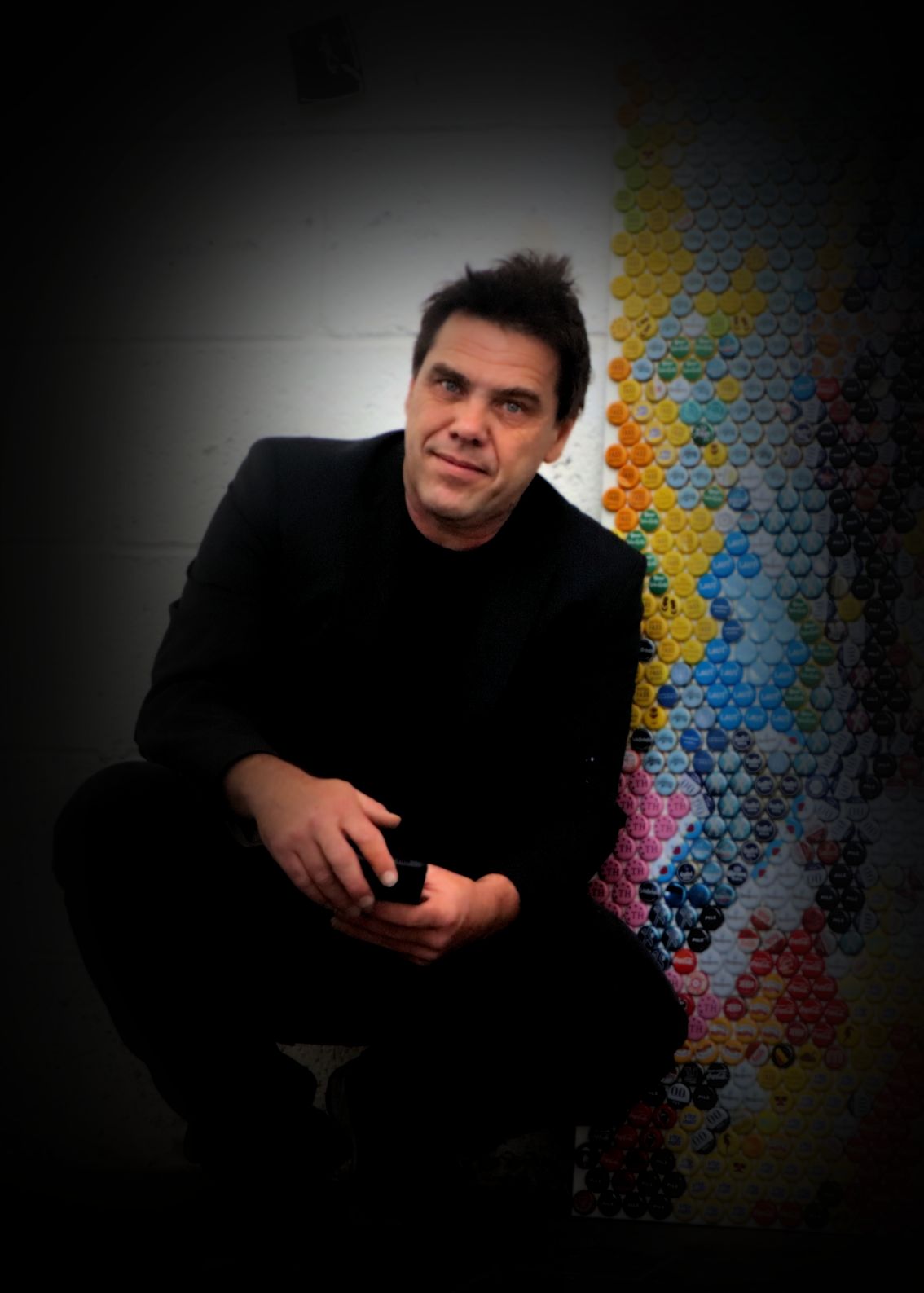Der Künstler
"Ich sehe meine Kunst als eine einzigartige Möglichkeit, meine Leidenschaft für Musik und gelebte Erfahrungen mit meiner künstlerischen Kreativität zu verbinden. Durch die Verwendung von Kronkorken als Medium schaffe ich nicht nur faszinierende und ästhetisch ansprechende Bilder, sondern auch eine visuelle Hommage an die Energie, die Gemeinschaft und die Emotionen, die ich bei Konzerten, Festivals und auf Reisen erlebt habe. Meine Kunst ist purer kreativer Ausdruck von gelebten Gefühlen. Meine Vision als Künstler ist es, eine Brücke zwischen Kunst und Musik zu schlagen und Menschen auf eine tiefere und persönlichere Ebene zu berühren."

![]()
Henning Leuschner, geboren 1968 im Sauerland, hat sich seit 1989 in Köln niedergelassen und ist heute als renommierter bildender und freischaffender Künstler tätig. Vor seiner künstlerischen Laufbahn war der ausgebildete Sozialarbeiter seit 1996 in verschiedenen Führungspositionen in der Jugendhilfe des LVR tätig, leitete Einrichtungen freier Jugendhilfeträger und arbeitet, neben seiner Kunst, als freiberuflich systemischer Supervisor, Coach und Organisationsentwickler im Rheinland.
Sein künstlerisches Werk umfasst seit Beginn seiner Tätigkeit vorwiegend Porträts, aber auch Stillleben, Landschaften und Stadtimpressionen, die er aus gebrauchten Kronkorken kreiert. Leuschner, ein leidenschaftlicher Musikliebhaber und Weltenreisender, schöpft seine Inspirationen aus den vielfältigen Eindrücken, die er bei Konzerten, Musikfestivals und auf seinen Reisen sammelt. Die Kunst des Autodidakten begann im Jahr 2013 auf ungewöhnliche Weise: Bei einer Gartenfeier entdeckte er das Potenzial der liegengebliebenen Kronkorken und schuf daraus spontan ein Kunstwerk, das später auf dem Gartentisch weiterentwickelt und vollendet wurde.
Seine experimentellen Kunstobjekte fanden schließlich in der Form von Bildern ihre Vollkommenheit. Als Upcycling-Künstler ist Leuschner getrieben von dem Wunsch, Kunst und Leben nachhaltig zu verbinden. Seine Werke sind Ausdruck einer tiefen Auseinandersetzung mit der Umwelt und der kreativen Umgestaltung von Alltagsgegenständen zu einzigartigen Kunstwerken. Leuschners Arbeiten reflektieren nicht nur seine künstlerische Leidenschaft, sondern auch seinen innovativen Ansatz, Kunst als nachhaltigen Dialog zwischen Mensch und Material zu gestalten.
![]()
![]()
Henning Leuschner beschreibt seine Kronkorkenkunst nachdrücklich als ein menschliches Kulturprodukt und das Resultat eines kreativen Trinkprozesses – eine analoge Kunstform in einer zunehmend digitalen Welt. Der Ausgangspunkt für jedes seiner Kunstwerke ist eine tiefgehende Auseinandersetzung mit Lebensereignissen, die er verinnerlicht und in einer riesigen Motivsammlung aus tausenden von Kronkorken festhält. Diese werden nahtlos zu einzigartigen Kunstwerken zusammengefügt, die durch ihre vollkommene Harmonie bestechen.
Leuschners Werke bedürfen keiner theoretischen Erklärungen. Ihre überwältigende Präsenz spricht für sich selbst und lässt den Betrachter sprachlos zurück. Die Kunstwerke entfalten ihre Wirkung unabhängig von Schulen oder Konzepten, ergreifen den Betrachter und hinterlassen einen nachhaltigen Eindruck. Durch Lichtwechsel und Perspektivänderungen bieten sie immer wieder neue Wahrnehmungen und Eindrücke.
Jedes seiner Kunstwerke erzählt eine Reise, die in einer einzigen, eindrucksvollen Szene gipfelt. Jeder einzelne Kronkorken hat während des Verkostungsprozesses seine eigene Geschichte erlebt, die sich in das Gesamtwerk einfügt. Diese Geschichten verschmelzen zu einem Ganzen, das der Betrachter nur erahnen kann, wodurch jedes Bild aus tausenden von individuellen Erlebnissen besteht.
Henning Leuschners Kunst ist ein lebendiges Zeugnis seiner Fähigkeit, die Essenz des menschlichen Erlebens in einer innovativen und inspirierenden Form festzuhalten. Seine Werke fordern den Betrachter auf, die verborgene Schönheit im Alltäglichen zu erkennen und die unerwartete Tiefe in den einfachsten Materialien zu schätzen.
![]()
Die Werke entstehen im Arbeitsatelier in der Lichtstr. 46 und dies ist Teil der Ateliergemeinschaft „Refugium“, gelegen im Herzen von Ehrenfeld, dem Szene- und Künstlerviertel Kölns zwischen Live Music Hall und der Vulkanhalle. Seit Beginn der künstlerischen Tätigkeit wurden insgesamt bis zum Frühjahr 2024 insgesamt ca. 140 Kunstwerke geschaffen, von denen sich eine Vielzahl mittlerweile durch Verkauf im Privatbesitz befindet.
![]()